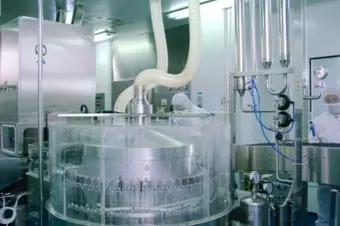Gamma-Aminobutyric acid API Manufacturers & Suppliers
Find, compare & contact
Filters
Custom request?
Type
Production region
Qualifications
Country of origin
Distributor
Produced in:
Established in: 1987
MOQ: 1 kg
Employees: 50+

ISO 9001:2015 & SGS audited supplier

One-stop CDMO Solutions for APl and Key intermediates

Specialized in APIs & Pharmaceutical Intermediates for 38 years
+ 0
All certificates

Professionalism: 20 years of experiences in pharma

Responsibility: One-step supply solution

Reliability: Considerate after-sales service
+ 0
All certificates
How does it work?
You can register for free as long as you are registering on behalf of a legal company related to the pharmaceutical industry
Search in the search bar the product that you’re looking for. We’ll show you an overview of all available suppliers. Use the filters to select the relevant suppliers only
Have you found interesting suppliers? Then it’s time to contact them. Use the send inquiry button and send them a message. You can send for each product, 3 inquiries per week
Suppliers get notified by Pharmaoffer that they’ve received a new inquiry. They will come back to you with their questions, certificates, and offer in the chat on Pharmaoffer. We will send you an email in case of any news
Does the supplier meet your quality and commercial requirements? Then you can place the order. Just follow the steps of our order module
Looking for Gamma-Aminobutyric acid API 56-12-2?
- Description:
- Here you will find a list of producers, manufacturers and distributors of Gamma-Aminobutyric acid. You can filter on certificates such as GMP, FDA, CEP, Written Confirmation and more. Send inquiries for free and get in direct contact with the supplier of your choice.
- API | Excipient name:
- Gamma-Aminobutyric acid
- Synonyms:
- 4-aminobutanoic acid , 4-aminobutyric acid , 4Abu , GABA , gamma-Aminobutyric acid , piperidic acid , piperidinic acid , γ-amino-n-butyric acid , γ-aminobutanoic acid , γ-Aminobuttersäure , γ-aminobutyric acid , ω-aminobutyric acid
- Cas Number:
- 56-12-2
- DrugBank number:
- DB02530
- Unique Ingredient Identifier:
- 2ACZ6IPC6I
General Description:
gamma-Aminobutyric acid, identified by CAS number 56-12-2, is a notable compound with significant therapeutic applications. The most common inhibitory neurotransmitter in the central nervous system.
Classification:
gamma-Aminobutyric acid belongs to the class of organic compounds known as gamma amino acids and derivatives. These are amino acids having a (-NH2) group attached to the gamma carbon atom, classified under the direct parent group Gamma amino acids and derivatives. This compound is a part of the Organic compounds, falling under the Organic acids and derivatives superclass, and categorized within the Carboxylic acids and derivatives class, specifically within the Amino acids, peptides, and analogues subclass.
Categories:
gamma-Aminobutyric acid is categorized under the following therapeutic classes: Acids, Acyclic, Amino Acids, Amino Acids, Peptides, and Proteins, Aminobutyrates, Butyrates, GABA Agents, Neurotransmitter Agents. These classifications highlight the drug's diverse therapeutic applications and its importance in treating various conditions.
Gamma-Aminobutyric acid is a type of Central Nervous System Agents
Central Nervous System (CNS) Agents are a crucial category of pharmaceutical Active Pharmaceutical Ingredients (APIs) that specifically target the central nervous system. The CNS encompasses the brain and spinal cord, playing a vital role in regulating and controlling various bodily functions, including cognition, movement, emotions, and sensory perception. These agents are designed to interact with specific receptors, enzymes, or ion channels within the CNS to modulate neural activity and restore normal functioning.
CNS agents comprise a diverse range of pharmaceutical APIs, including analgesics, anesthetics, antipsychotics, sedatives, hypnotics, anti-epileptics, and antidepressants. Each subcategory addresses distinct neurological disorders and conditions. For instance, analgesics alleviate pain by targeting receptors in the brain and spinal cord, while antipsychotics are employed to manage psychosis symptoms in mental illnesses such as schizophrenia.
The development of CNS agents involves rigorous research, molecular modeling, and extensive clinical trials to ensure safety, efficacy, and specific target engagement. Pharmaceutical companies invest significant resources in identifying novel drug targets, synthesizing new compounds, and optimizing their pharmacological properties. These agents undergo rigorous regulatory evaluations and must adhere to stringent quality standards and guidelines.
Given the prevalence of CNS disorders globally, the market demand for effective CNS agents is substantial. The development of innovative CNS APIs not only improves patient outcomes but also provides valuable commercial opportunities for pharmaceutical companies. Continued advancements in CNS agent research and development hold the promise of groundbreaking therapies that can improve the quality of life for individuals affected by neurological conditions.
Gamma-Aminobutyric acid manufacturers | traders | suppliers
We have 2 companies offering Gamma-Aminobutyric acid produced in 0 different countries.
Get in contact with the supplier of your choice:
- Sinoway industrial Co.,Ltd from China, product country of origin China
- Changzhou Comwin Fine Chemicals Co., Ltd from China, product country of origin China
Let the supplier know whether you are looking for a product with a specific monograph such as EP (Ph. Eur.), USP, JP, BP or another quality. Or, whether you are looking for hydrochloride (HCl), anhydricum, base, micronisatum or a specific purity.
You can use the filters to find high-quality suppliers. For example, you can select GMP, FDA or ISO certified suppliers. Visit our FAQ page or use the chat box in the corner to get more information about Pharmaoffer.











